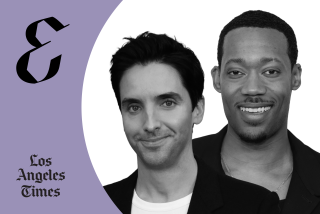‘Eyes on the Prize III’ arrives on HBO during a renewed ‘assault on equality’

- Share via
The new series “Eyes on the Prize III,” which covers the civil rights movement from 1977 to 2015, has been in development for many years. The fact that it arrives on HBO Tuesday, in the midst of an all-out assault on diversity that threatens to roll back the progress chronicled in the first two “Eyes” series, is a fluke of timing.
But even if that wasn’t planned, executive producer Dawn Porter isn’t complaining.
“There’s no better time for this series to be coming out,” she said in a recent interview. “It’s so difficult to tell history and to tell what actually happened now. Today we have this assault on equality and efforts to make sure that we have a level playing field. I refuse to say ‘DEI’ because it has been weaponized in a way that is wholly inappropriate.”
The first “Eyes,” which premiered on PBS in 1987, was created by Henry Hampton and is a canonical work of not just the civil rights movement but also the docuseries format. In telling the story of the movement from 1954 to 1965 — the key years of marches, sit-ins, grassroots organizing and federal legislation including the Civil Rights Act of 1964 — it brought the scope of the struggle to a broad audience. Its narrative strands included not just major historical figures, like Martin Luther King Jr., who wasn’t yet well known when he spearheaded the Montgomery Bus Boycott in 1955, but also men and women who put their lives on the line for equality — people like Moses Wright, who identified the white men who kidnapped and brutally murdered his great nephew, 14-year-old Emmett Till, that same year.
The second “Eyes,” which premiered in 1990 and is almost impossible to view outside of schools due to licensing issues, picks up where the original left off and goes through the mid-’80s. And the new series, subtitled “We Who Believe in Freedom Cannot Rest,” takes us through the Obama presidency and to the brink of the first Trump administration, which brought a preview of the current and overt hostility to all that was gained in the civil rights movement. (HBO will air two episodes back-to-back each night through Thursday, and all episodes will be available to stream on Max starting Tuesday.)
“The Disappearance of Miss Scott” reacquaints viewers with a jazz virtuoso who was the first Black person to have a TV show and was almost erased by the government.
“We are right back where we started,” said Smriti Mundhra, who directed Episode 5 of the new series. “There’s this sort of boogeyman attack on DEI and what have you, and it’s all part of the same narrative. There’s a swift backlash when there’s any progress. That’s not to say that progress won’t happen. I think it’s two steps forward, one-and-three-quarter step back. And that hasn’t changed in generations.”

The episode directed by Mundhra, “We Don’t See Color 1996-2013,” looks at the war on affirmative action — the movement to combat racism in education, employment and elsewhere and the forerunner to what is now commonly called DEI — and the fight to keep public schools integrated, in the spirit of the Supreme Court’s 1954 Brown vs. Board of Education decision. Like the other episodes, which focus on issues including fair housing, environmental racism (which often boils down to corporate toxic chemical accidents in minority neighborhoods), and the disproportionate effect of the AIDS crisis on minorities, this one is generally more interested in organizers and activists on the ground than high-profile names.
Porter sees one throughline from the original docuseries to the new one as the importance of everyday people taking risks to do brave things.
“I think that there’s a perception that the civil rights movement was only in the 1960s,” she said. “Part of the message of the entire series is that civil rights activity continues. I hope that this series does emphasize that we are never fully powerless. We just have to be more creative about our resistance. These are hopeful stories, but they’re also true.”
Watching the original series is a reminder of how much things have changed, even if they sometimes feel the same. There’s something about that first “Eyes” that feels remarkably pure and purposeful. It’s not hard to feel outrage at the sight of sheriffs siccing police dogs on innocent protesters, or gangs of toughs beating Black college students for sitting at a lunch counter. Contemporary challenges are more complex, if no less urgent.
“Today, discrimination takes much more subtle forms,” Porter said. “So you pollute where Black and brown people live, you refuse to allow them housing, you over-police them. 2025 is closer to 1968 than to 1988. So the next group in 10 years that does ‘Eyes,’ we’ll see how they approach it because I do think that this series will live on.”
If it does, it will have quite a story to tell.
“I feel like there’s no way to swim against this tide that’s coming,” Mundhra said. “I hope that this series will remind people that we know how to fight, and we can fight again. It’s okay to feel despondent, but it’s time to summon our resolve.”
Or, as Porter puts it: “It’s hard to feel active when you’re suffering, but we got to get up.”
More to Read
The complete guide to home viewing
Get Screen Gab for everything about the TV shows and streaming movies everyone’s talking about.
You may occasionally receive promotional content from the Los Angeles Times.







